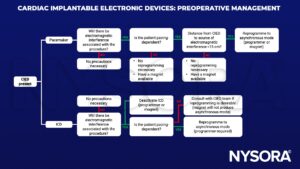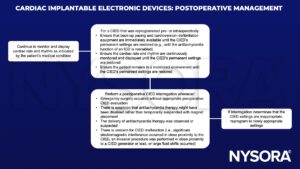Learning objectives
- Preoperative assessment and precautions for patients with a CIED
- Intraoperative and postoperative management of patients with a CIED
Definition
- Cardiac implantable electronic device (CIED) refers to any permanently implantable cardiac pacemaker or any implantable cardioverter–defibrillator (ICD), as well as any cardiac resynchronization therapy device
Possible perioperative adverse events
| Device function | Damage to the device |
| Inability to deliver pacing or shocks |
|
| Lead-tissue interface damage |
|
| Changes in pacing behavior | |
| Electrical reset to the backup pacing mode |
|
| Inappropriate ICD therapies | |
| Clinical | Hypotension |
| Tachyarrhythmia and bradyarrhythmia | |
| Myocardial tissue damage | |
| Myocardial ischemia and infarction |
Magnet use
- Application of a magnet to a modern pacemaker produces an asynchronous mode of pacing to protect a patient from the effects of electromagnetic interference
- A magnet can be secured over the pulse generator of an ICD to suspend the arrhythmia detection function and prevent discharge. Subsequent removal of the magnet promptly reactivates the ICD
Management
- Preoperative
- Determine whether the patient has a CIED
- Determine the CIED type, manufacturer, and primary indication for placement
- Determine whether the patient is pacing-dependent
- Determine the CIED’s current settings and that it is functioning properly by interrogating the cardiac implantable electronic device or obtaining the most recent interrogation report
- Determine possible sources of electromagnetic interference:
- Electrosurgery (monopolar > bipolar)
- Evoked potential monitors
- Nerve stimulators (twitch monitors)
- Fasciculations
- Shivering
- Large tidal volumes
- External defibrillation
- Magnetic resonance imaging
- Radiofrequency ablation or lesioning
- Extracorporeal shock wave lithotripsy
- Electroconvulsive therapy
- Determine precautions:

- Intraoperative
- Continuously monitor and display the electrocardiogram and SpO2
- Perform continuous peripheral pulse monitoring for all patients
- If unanticipated CIED interactions occur, temporarily suspend the procedure until the source of interference can be identified and eliminated or managed
- Interference source management:
- Interference source management:
Electrosurgery Position the electrode so that the current does not pass through or near the CIED generator and leads
Avoid proximity of the electrical current to the generator or leads
When possible, use bipolar electrosurgery instead of monopolar When monopolar electrosurgery is necessary, use intermittent and irregular bursts at the lowest feasible energy levels
Use an ultrasonic (harmonic) scalpel If monopolar electrosurgery is planned superior to the umbilicus, ensure that the pacing function is altered to an asynchronous pacing mode in pacing-dependent patients and suspend an ICD’s antitachycardia function, if present. Ensure that the patient is in a monitored environment Radiofrequency ablation Keep the radiofrequency current path (electrode tip to current return pad) as far away from the generator and leads as possible
If radiofrequency ablation is planned superior to the umbilicus, ensure that the pacing function is altered to an asynchronous pacing mode in pacing-dependent patients and suspend an ICD’s antitachycardia function, if present. Ensure that the patient is in a monitored environment Lithotripsy Avoid focus of the lithotripsy beam near the generator
Magnetic Resonance Imaging (MRI)
Move the patient outside of the immediate MRI area
Interrogate the CIED before the MRI scan
Suspend the antitachycardia function of an ICD before the MRI scan Alter the pacing function to an asynchronous pacing mode in pacing-dependent patients before the MRI scan
Ensure that someone capable of programming the CIED remains in attendance for the duration of the MRI scan
Ensure that someone capable of performing advanced life support remains in attendance for the duration of the MRI scan
Reinterrogate the CIED and restore its permanent settings after the MRI is completed Radiofrequency identification devices
Avoid the use of these devices in close proximity to the CIED
Monitor for signs of electromagnetic interference and be prepared to stop using the radiofrequency identification device if interference occurs
Electroconvulsive Therapy Alter the pacing function to an asynchronous pacing mode in pacing-dependent patients
Suspend an IDC’s antitachycardia function, if present
Monitor for and be prepared to manage postconvulsive sinus tachycardia
Monitor for and treat ventricular arrhythmias that may occur secondary to the hemodynamic effects of electroconvulsive therapy

- Postoperative

Suggested reading
- Practice advisory for the perioperative management of patients with cardiac implantable electronic devices: pacemakers and implantable cardioverter-defibrillators 2020. Apfelbaum JL, Schulman PM, Mahajan A, Connis RT, Agarkar M. Anesthesiology. 2020;132:225–252.
- Stone ME, Salter B, Fischer A. Perioperative management of patients with cardiac implantable electronic devices. British Journal of Anaesthesia. 2011;107:i16-i26.
We would love to hear from you. If you should detect any errors, email us customerservice@nysora.com